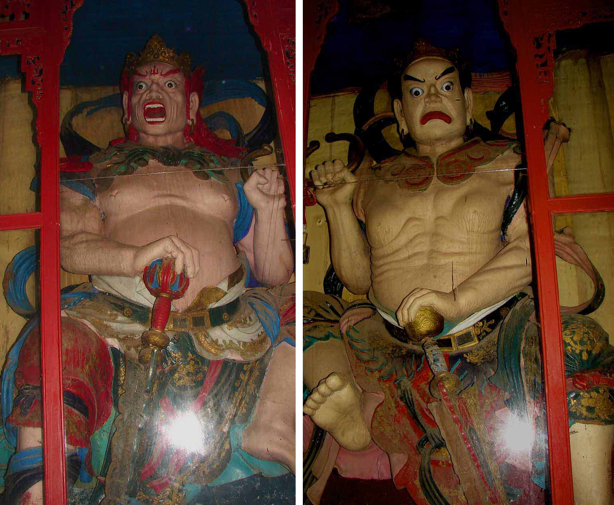
Heng Ha Er Jiang (哼哈二将, the two Generals Heng and Ha), from Fengdu China
Breathing deeper…
Above are two more Kongo-rikishi (“Guardian King”) statues of the type that we talked about in Part 1 of “Aiki, Iki, Kokyu, Heng-Ha and Aun“.
This time the statues are from the ghost town of Fengdu China – which is an entire city modelled on the Chinese Hell of Taoist mythology, built more than 1800 years ago. The City of Ghosts was a place of worship before the flooding of the Three Gorges due to the Three Gorges Dam Project. Today it mostly lies underwater – except for the sections that have been reconstructed (with some of the original structures used) for the tourist industry.
In the picture above the General Heng stands on the right – 哼, for inhaling. Note that his mouth is closed and his abdomen is contracted (this is the Naraen Kongo in Japan, with his mouth closed in the “un” syllable of “Aun”).
The General Ha stands on the left – 哈, for exhaling. Note that his mouth is opened and his abdomen is expanded (this is the Misshaku Kongo in Japan, with his mouth open in the “A” syllable of “Aun”).
Both of these generals are in “power stances”, stances that are meant to demonstrate their great power. This, especially the General Ha, may remind you of another demonstration of great power painted by Eiji Tamura:
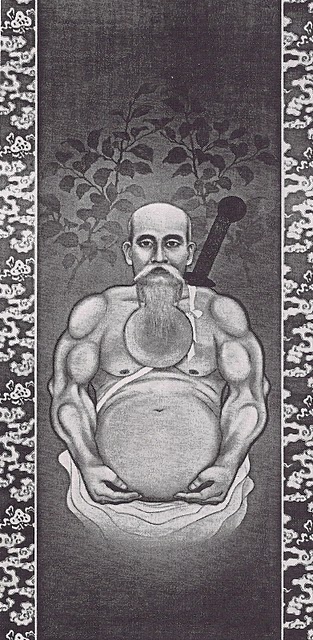
Morihei Ueshiba, O-Sensei by Eiji Tamura
Note the similarity to the statue of General Ha, especially in the abdomen, which is a classic representation of breath power development.
Did Morihei Ueshiba ever consider the Guardian Kings? Well – take a look at this statement:
みな水火の動きで生々化々大金剛力をいただいて水火の仕組みになっている。水火結んで息陰陽に結ぶ。
All is the movement of Water and Fire, in the continuous cycle of the mechanism of Water and Fire received from the Great Guardian King (Dai Kongo-riki). Connect Water and Fire and connect Iki (breath) with In-Yo.
And so, we get back to “breath power”. If you read the first part of “Aiki, Iki, Kokyu, Heng-Ha and Aun“, then you may remember this statement by Aikido Founder Morihei Ueshiba:
武産の武の阿吽の呼吸の理念力
The martial art of Takemusu is the power of the principle of A-un breathing (kokyu)
So we know that “A-un” breathing (“Aun no kokyu”, in this case”) was very important to O-Sensei.
We also know that the Japanese “A-un” is equivalent, in this case, to the Chinese “Heng-ha” – the Agyo (“A-form) of Naraen Kongo being General Ha and the Ungyo (“Un-form”) of Misshaku Kongo being General Heng.
Further, we know from the previous article that in China “Heng-Ha” breathing is a type of conditioning and training used employed in the martial arts.
Now, back to the figure of General Ha. As noted above, the General’s mouth is open and he is exhaling. In spite of the fact that he is exhaling his abdomen is strongly expanded, pressurized.
If we then look at General Heng, we note again that his mouth is closed and he is inhaling. In spite of the fact that he is inhaling his abdomen is strongly contracted.
So now we can see that, when we are talking about “Heng-Ha” breathing, we are generally speaking about Reverse Breathing (some exceptions aside) – the abdomen working in reverse of the way that it normally functions during the breathing process. That’s vastly oversimplified, but I’m not going to get any further into physical detail right now (or ever, probably, over the internet).
For now, we can see that the statement above by Morihei Ueshiba might now be translated:
武産の武の阿吽の呼吸の理念力
The martial art of Takemusu is the power of the principle of reverse breathing (kokyu)
But wait, that’s not all!
Here’s another interesting statement by Morihei Ueshiba:
合気道は、魂の学びである。魂魄阿吽の呼吸である。
Aikido is the study of the soul. It is “Konpaku Aun no Kokyu”.
We saw above that “Aun no Kokyu” can be translated (roughly) as “Reverse Breathing” – but what about “Konpaku”? And what’s this stuff about the “soul”?
Let’s start with “Konpaku”. This is a phrase composed of two Kanji, the first of which means “soul”, and the second of which means…”soul”.
Got it?
Actually, there are two souls in Chinese cosmology. The “Hun” (魂 / “Kon”) soul – which is associated with Yo (Yang) and the intellect, and the “po” (魄 / “paku”) soul – which is associated with In (Yin) and the body.
Now, back to this phrase, which we examined in “Aikido and the Structure of the Universe“:
一霊四魂三元八力
One Spirit, Four Souls, Three Origins, Eight Powers
In that article we saw that Ichrei Shikon Sangen Hachiriki represents both the structure of the Universe and the structure of Aikido.
The first section, “Ichirei Shikon” (“One Spirit, Four Souls”), is the structure of the spirit world.
In Shinto cosmology humans possess one spirit and four souls – the turbulent (aramitama), the tranquil (nigimitama), the happy (sakimitama) and the wondrous (kushimitama).
The “naohinomitama” is the one spirit that acts as kind of a container for the four souls.
Kushimitama and Sakimitama are considered to be specialized subsets of Nigimitama, leaving really just two souls – Nigimitama associated with In and Aramitama associated with Yo.
When the two souls of Nigimitama and Aramitama are acting in a connected fashion as unified opposing forces, you have “Naohinomitama”, the “correct mind” which acts a container for both souls (in orther words, the One Spirit). Generally speaking, when the two souls are not balanced in opposition then Misogi is used to correct the balance – but more on that another time.
In any case, we know that we have two In-Yo forces that animate and energize the mind and body when they are working together correctly – ever hear of “Unification of Mind and Body”?
This is the unification of mind and body (which is a phrase used by Morihei Ueshiba even prior to Koichi Tohei) down to the level of the psycho-spiritual, perhaps so far as to represent the coordinated actions of the voluntary and involuntary systems in the body.
Further, we can now approach a translation of “Konpaku Aun no Kokyu” as “In-Yo Reverse Breathing” – with the caveat that the “In-Yo” here has some very far reaching and complex interactive implications.
If you’ve been participating in a certain type of training then this translation may ring some bells for you – even more so if you consider “reverse breathing” as a connection between two opposing forces, such as those described in “Aikido without Peace or Harmony“.
Now, back to the soul, as in “Aikido is the study of the soul”.
This seems quite straightforward – and it might be, but first, let’s consider that the character used for “soul” is not quite the soul in the usual Western sense of the soul, but is rather that section of the soul which activates the intellect – the character used here is actually the first character of the compound “Konpaku” above.
In Asia (and Japan) the “container” for that soul is the “spirit” (as in the One Spirit 一霊, which contains the Four Souls 四魂) – unlike in the West, where they are generally considered to be the same thing.
In this case, the character used – the Yo soul associated with the intellect, might be more properly translated as “intent” – the force of the intellectual decision that resides within the spirit or mind as a whole. This leaves us with:
合気道は、魂の学びである。
Aikido is the study of intent.
Again, those participating in a certain kind of training will see the implications of this statement at once.
Even if you are not – “intent” is a primary factor in Chinese martial arts – so much so that entire arts are named after it.
Which leads to this interesting statement by Yang Chengfu (from The Ten Essentials of Tai Chi Chuan, Part 2):
The taiji classics say, ‘this is completely a matter of using intent rather than force’. When you practice taijiquan, let the entire body relax and extend. Don’t employ even the tiniest amount of coarse strength which would cause musculo-skeletal or circulatory blockage with the result that you restrain or inhibit yourself. Only then will you be able to lightly and nimbly change and transform, circling naturally.
Finally, compare the above statement to this one by Morihei Ueshiba:
そこで合気道は形はない。形はなく、すべて魂の学びである。すべて形にとらわれてはいけない。それは微妙な働きが出来なくなるからである。
There are no Forms in Aikido. No Forms, the study of intent is everything. You must not let everything be subsumed by Form. This is because you will become unable to move with subtlety.
Which has some rather far-reaching implications concerning the general practice of Aikido – if you ask me.
Christopher Li – Honolulu, HI



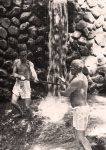
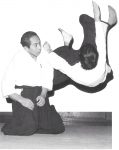
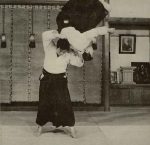

Leave a Reply